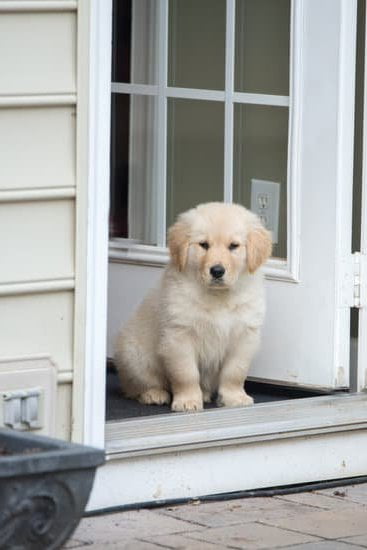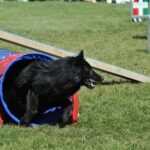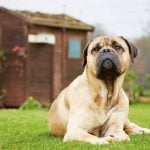Are you struggling with how to house train your 1-year-old dog? House training is an important aspect of responsible pet ownership and can make both your life and your dog’s life much easier. In this article, we will discuss the importance of house training for your 1-year-old dog and provide you with some helpful tips on how to successfully house train your furry friend.
When it comes to living with a dog, one of the most important skills to teach them is proper bathroom habits. House training not only keeps your home clean and odor-free but also helps prevent destructive behaviors and strengthens the bond between you and your dog. Understanding the significance of house training for your 1-year-old dog is crucial in ensuring a happy and harmonious living environment for both you and your pet.
In order to effectively house train your 1-year-old dog, it’s essential to first assess their current habits and behaviors. This will give you insight into their potty preferences, as well as any potential obstacles or challenges that may arise during the training process. By understanding your dog’s behavior, you can tailor your approach to best suit their individual needs and set them up for success.
Assessing Your Dog’s Current Habits and Behaviors
Evaluating Bathroom Behaviors
The first step in house training your 1-year-old dog is to assess their current bathroom habits and behaviors. Take note of how often they go potty, where they tend to do their business, and any signs they may give when they need to relieve themselves. Understanding your dog’s natural tendencies will help you create an effective house training plan tailored to their specific needs.
Identifying Triggers and Cues
Pay close attention to any triggers or cues that may indicate when your dog needs to go outside. This could include behaviors such as sniffing around, circling a specific spot, or whining. By recognizing these cues, you can proactively guide your dog to the designated potty area before accidents happen indoors.
Establishing a Baseline Schedule
Take note of the times of day when your dog typically needs to go potty. Establishing a baseline schedule will help you anticipate their bathroom needs and set consistent potty break times. This routine will not only benefit your dog by providing structure, but it will also streamline the house training process for both of you.
By carefully assessing your 1-year-old dog’s current habits and behaviors, you can develop a personalized house training plan that addresses their specific needs and sets them up for success in learning how to effectively communicate their bathroom needs.
Remember by following these tips on assessing your 1 year old dog’s current habits and behaviors should set you on the right path for successful house training techniques using positive reinforcement and rewards to encourage good bathroom behavior.
Establishing a Consistent Routine for Potty Breaks
One of the most important aspects of house training your 1-year-old dog is establishing a consistent routine for potty breaks. Just like with humans, dogs thrive on routine and predictability. By setting a schedule for your dog’s potty breaks, you can help them understand when and where they should go to the bathroom.
Start by observing your dog’s current habits and behaviors to determine how often they need to go outside. Most dogs need to relieve themselves first thing in the morning, after meals, and before bed. Additionally, they may need to go out every few hours throughout the day. Once you have an understanding of your dog’s bathroom needs, create a potty break schedule that aligns with those needs.
When implementing your potty break routine, be sure to take your dog to the same spot each time. The scent of their previous eliminations will encourage them to go in that area again. Use verbal cues such as “go potty” or “do your business” while they are in their designated spot to reinforce the purpose of their outdoor bathroom trips.
Consistency is key when establishing a routine for potty breaks. By providing clear expectations and regular opportunities for bathroom breaks, you are setting your 1-year-old dog up for success in their house training journey.
| House Training Tip | Description |
|---|---|
| Observe Your Dog | Take note of your dog’s bathroom habits and create a schedule based on their needs. |
| Designated Bathroom Spot | Take your dog to the same spot each time you go outside for consistency. |
| Use Verbal Cues | Reinforce the purpose of outdoor bathroom trips with consistent verbal cues. |
Using Positive Reinforcement and Rewards to Encourage Good Bathroom Behavior
House training a 1-year-old dog can be challenging, but using positive reinforcement and rewards can make the process much smoother. One of the most effective ways to encourage good bathroom behavior in your dog is by rewarding them every time they go potty in the right place. This can be done with treats, verbal praise, or even a favorite toy. The key is to make sure the reward is something that your dog finds truly motivating.
When using positive reinforcement, timing is crucial. As soon as your dog finishes going potty in the correct spot, immediately praise them and give them a reward. This will help your dog associate going to the bathroom in the right place with receiving something positive in return, making them more likely to repeat this behavior in the future.
It’s important to be consistent with your rewards and praise every time your dog goes potty in the designated area. This consistency will help your dog understand what is expected of them and reinforce good bathroom habits. Remember that every dog is different, so it may take some trial and error to figure out what type of reward works best for your furry friend.
| Positive Reinforcement Techniques | Using Rewards for Bathroom Behavior |
|---|---|
| Immediate praise and reward after potty breaks | Consistency with rewards for good behavior |
| Discovering what motivates your specific dog | Trial and error for finding effective rewards |
Implementing positive reinforcement and rewards into your house training routine can significantly speed up the process of teaching your 1-year-old dog where they should go potty. With patience, consistency, and plenty of encouragement, you’ll find that even an older pup can learn new tricks – including how to house train effectively.
Recognizing and Addressing Common Obstacles and Setbacks in House Training
When house training a 1-year-old dog, it’s important to recognize that there may be obstacles and setbacks along the way. Understanding these common challenges can help you address them effectively and continue making progress in your dog’s bathroom habits.
Understanding Regression
It’s not uncommon for dogs, especially older puppies, to experience regression in their house training. This can happen for a variety of reasons, such as changes in routine, stress, or medical issues.
If you notice your 1-year-old dog having accidents indoors after previously being house trained, it’s important to assess the situation and determine the cause of the regression. Consulting with a veterinarian can help rule out any medical issues that may be contributing to the problem.
Dealing With Accidents
Accidents are bound to happen during the house training process, especially with an older puppy. It’s crucial to respond to accidents calmly and without punishment. Clean up any messes thoroughly with an enzymatic cleaner to remove traces of urine or feces that could attract your dog back to the same spot. Avoid using ammonia-based cleaners, as they can mimic the scent of urine and encourage further accidents in the same area.
Addressing Separation Anxiety
Separation anxiety can be a common obstacle in house training for older puppies, including 1-year-old dogs. Dogs with separation anxiety may exhibit destructive behavior or have accidents indoors when left alone. It’s important to address separation anxiety through behavior modification techniques and gradual desensitization to being alone. Providing mental stimulation and comfort items, such as interactive toys and a cozy crate den, can also help alleviate separation anxiety and improve house training progress.
By recognizing these common obstacles and setbacks in house training, you can effectively address them and continue working towards successful bathroom habits for your 1-year-old dog. Remember that patience, consistency, and positive reinforcement are crucial elements in overcoming these challenges as you guide your dog towards becoming reliably house trained.
Exploring Different House Training Methods and Techniques
When it comes to house training your 1-year-old dog, there are a variety of methods and techniques that you can use to effectively teach them good bathroom habits. Here are some different approaches you can consider:
- Paper or Pad Training: Some pet owners opt for training their dogs to eliminate on a specific pad or area within the home. This method is useful for individuals who may not have easy access to outdoor potty areas or for dogs who may have health issues that prevent them from going outside frequently.
- Bells and Whistles: Teaching your dog to ring a bell or use a specific signal when they need to go outside can be an effective way to communicate their needs. By establishing this cue, your dog will learn to associate the action with going outside for a potty break.
- Scheduling Bathroom Breaks: Setting a regular schedule for your dog’s potty breaks can help establish consistency and predictability, which are essential components of successful house training. Taking your dog out first thing in the morning, after eating, and before bedtime are key times for bathroom breaks.
Each dog is unique, so it’s important to assess what method or combination of techniques will work best for your furry friend. Be patient and observant as you experiment with different approaches, and remember that positive reinforcement is crucial in all instances.
It’s important not to get discouraged if one method doesn’t yield immediate results. Keep trying new techniques until you find the right fit for your 1-year-old dog. With time and persistence, you’ll find an approach that works best for both you and your beloved pet.
Utilizing Crate Training as a Tool for Successful House Training
Crate training can be an effective tool when it comes to house training your 1-year-old dog. When used properly, a crate can provide a safe and comfortable space for your dog while also helping to establish good bathroom habits. Here are some tips on how to utilize crate training for successful house training:
- Choose the right crate: Select a crate that is big enough for your dog to stand up, turn around, and lie down comfortably. The crate should also have proper ventilation and be made of sturdy materials.
- Introduce the crate gradually: Allow your dog to become familiar with the crate by propping the door open and placing treats or toys inside. Encourage your dog to go in and out of the crate voluntarily.
- Establish a routine: Use the crate as a part of your dog’s daily routine, especially during times when you cannot directly supervise them. This will help them develop self-control and learn to hold their bladder until it’s time for a potty break.
Crate training should never be used as a form of punishment, as this can create negative associations with the crate. Instead, it should be a positive and safe space for your dog. With patience and consistency, crate training can be an effective tool in house training your 1-year-old dog.
Remember that every dog is different, so it’s important to tailor the crate training process to suit your individual pet’s needs. If you’re unsure about how to house train my 1 year old dog using crate training, consider seeking advice from a professional dog trainer who can provide personalized guidance based on your dog’s behavior and habits.
Patience and Persistence
House training a 1-year-old dog requires patience and persistence. It is important to understand that effective house training takes time and effort. Each dog is different, and some may pick up on the training quicker than others. Consistency in training is key to successfully house training your 1-year-old dog.
The time and effort needed for effective house training can vary depending on your dog’s breed, previous living conditions, and individual personality. Some dogs may take longer to understand the concept of house training, while others may catch on quickly. It is important to be patient with your dog and provide consistent, positive reinforcement throughout the training process.
Understanding the time and effort needed for effective house training also involves recognizing that setbacks are normal. Your 1-year-old dog may have accidents in the house despite your best efforts. It’s essential to stay patient and continue with the established routine and positive reinforcement to help your dog learn good bathroom habits. By remaining persistent and calm, you can help your dog overcome obstacles and successfully learn how to eliminate outside.
In addition, maintaining consistency in the house training process will require both patience and persistence on your part. This means sticking to a regular potty schedule, providing rewards for good behavior, and being understanding when accidents happen. With time and dedication, you can effectively house train your 1-year-old dog and celebrate success as they develop good bathroom habits.
Maintaining Consistency and Patience in the Process
Once you have established a consistent routine for potty breaks and are using positive reinforcement to encourage good bathroom behavior, it is important to maintain consistency and patience in the house training process. It’s important to remember that every dog is different, and some may take longer to fully grasp the concept of house training. It’s crucial not to become frustrated or impatient with your 1-year-old dog during this process.
Consistency is key when it comes to house training a 1-year-old dog. This means sticking to the established routine for potty breaks, using the same designated bathroom area each time, and consistently rewarding your dog for good bathroom behavior. Additionally, it’s important to be patient with your furry friend as they learn this new skill. Understanding that accidents may happen and being patient with your dog through setbacks will ultimately lead to more successful house training.
In addition to consistency and patience, it’s also important to remain positive throughout the house training process. Keep in mind that your 1-year-old dog is doing their best to learn and please you. Offering plenty of praise, love, and encouragement will go a long way in reinforcing good bathroom habits. Remember, consistency, patience, and positivity are essential for effectively house training your 1-year-old dog.
Conclusion
In conclusion, house training a 1-year-old dog can be a challenging but rewarding process. By understanding the importance of house training and taking the time to assess your dog’s current habits and behaviors, you can establish a consistent routine for potty breaks and use positive reinforcement to encourage good bathroom behavior.
It is important to remember that patience and persistence are key in this process, as it may take some time for your dog to fully understand and adapt to the new routine.
As you navigate through the house training process, it is essential to recognize and address common obstacles and setbacks that may arise. Whether it’s accidents in the house or resistance from your dog, staying patient and maintaining consistency will be crucial in overcoming these challenges. It is also important to explore different house training methods and techniques to find what works best for your 1-year-old dog.
Ultimately, celebrating success in house training means ongoing maintenance of good bathroom habits. This requires continued patience, consistency, and positive reinforcement.
By utilizing crate training as a tool for successful house training and maintaining a regular potty break schedule, you can help ensure that your 1-year-old dog develops long-lasting good bathroom habits. Remember that every dog is different, so remain adaptable and attentive to your dog’s individual needs throughout the process of learning how to house train my 1 year old dog.
Frequently Asked Questions
Can a 1 Year Old Dog Still Be Potty Trained?
Yes, a 1 year old dog can still be potty trained. While it may take a little more time and patience compared to training a younger puppy, it is definitely possible with consistent training and positive reinforcement.
Is It Too Late to Train a 1 Year Old Dog?
It is not too late to train a 1 year old dog. Dogs of any age can learn new behaviors and habits with the right approach and consistency. It may take some extra effort, but it is definitely achievable.
Can You Potty Train 1 Year Old?
Yes, you can potty train a 1 year old dog. The key is to establish a consistent routine, provide plenty of opportunities for the dog to eliminate in the proper place, and use positive reinforcement to encourage good bathroom habits. With patience and persistence, it can be done.

Welcome to the blog! I am a professional dog trainer and have been working with dogs for many years. In this blog, I will be discussing various topics related to dog training, including tips, tricks, and advice. I hope you find this information helpful and informative. Thanks for reading!





